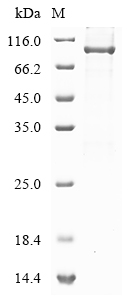Recombinant Human Short transient receptor potential channel 4-associated protein (TRPC4AP)
CAT:
399-CSB-EP840581HU-03
Size:
1 mg
Price:
Ask
- Availability: 24/48H Stock Items & 2 to 6 Weeks non Stock Items.
- Dry Ice Shipment: No




Recombinant Human Short transient receptor potential channel 4-associated protein (TRPC4AP)
- CAS Number: 9000-83-3
- Gene Name: TRPC4AP
- UniProt: Q8TEL6
- Expression Region: 2-797aa
- Organism: Homo sapiens
- Target Sequence: AAAPVAAGSGAGRGRRSAATVAAWGGWGGRPRPGNILLQLRQGQLTGRGLVRAVQFTETFLTERDKQSKWSGIPQLLLKLHTTSHLHSDFVECQNILKEISPLLSMEAMAFVTEERKLTQETTYPNTYIFDLFGGVDLLVEILMRPTISIRGQKLKISDEMSKDCLSILYNTCVCTEGVTKRLAEKNDFVIFLFTLMTSKKTFLQTATLIEDILGVKKEMIRLDEVPNLSSLVSNFDQQQLANFCRILAVTISEMDTGNDDKHTLLAKNAQQKKSLSLGPSAAEINQAALLSIPGFVERLCKLATRKVSESTGTASFLQELEEWYTWLDNALVLDALMRVANEESEHNQASIVFPPPGASEENGLPHTSARTQLPQSMKIMHEIMYKLEVLYVLCVLLMGRQRNQVHRMIAEFKLIPGLNNLFDKLIWRKHSASALVLHGHNQNCDCSPDITLKIQFLRLLQSFSDHHENKYLLLNNQELNELSAISLKANIPEVEAVLNTDRSLVCDGKRGLLTRLLQVMKKEPAESSFRFWQARAVESFLRGTTSYADQMFLLKRGLLEHILYCIVDSECKSRDVLQSYFDLLGELMKFNVDAFKRFNKYINTDAKFQVFLKQINSSLVDSNMLVRCVTLSLDRFENQVDMKVAEVLSECRLLAYISQVPTQMSFLFRLINIIHVQTLTQENVSCLNTSLVILMLARRKERLPLYLRLLQRMEHSKKYPGFLLNNFHNLLRFWQQHYLHKDKDSTCLENSSCISFSYWKETVSILLNPDRQSPSALVSYIEEPYMDIDRDFTEE
- Tag: N-terminal 6xHis-tagged
- Source: E.coli
- Field of Research: Epigenetics and Nuclear Signaling
- Assay Type: Developed Protein
- Relevance: Substrate-recognition component of a DCX (DDB1-CUL4-X-box) E3 ubiquitin-protein ligase complex required for cell cycle control. The DCX (TRPC4AP) complex specifically mediates the polyubiquitination and subsequent degradation of MYC as part of the DesCEND (destruction via C-end degrons) pathway. The DesCEND (destruction via C-end degrons) pathway recognizes a C-degron located at the extreme C terminus of target proteins, leading to their ubiquitination and degradation. The DCX (TRPC4AP) complex specifically recognizes proteins with an arginine at the minus 3 position (R-3 motif) at the C-terminus, such as MYC, leading to their ubiquitination and degradation. Also participates in the activation of NFKB1 in response to ligation of TNFRSF1A, possibly by linking TNFRSF1A to the IKK signalosome. Involved in JNK activation via its interaction with TRAF2. Also involved in elevation of endoplasmic reticulum Ca (2+) storage reduction in response to CHRM1.
- Purity: Greater than 85% as determined by SDS-PAGE.
- Activity: Not Test
- Length: Full Length of Mature Protein
- Form: Liquid or Lyophilized powder
- Buffer: If the delivery form is liquid, the default storage buffer is Tris/PBS-based buffer, 5%-50% glycerol. If the delivery form is lyophilized powder, the buffer before lyophilization is Tris/PBS-based buffer, 6% Trehalose, pH 8.0.
- Reconstitution: We recommend that this vial be briefly centrifuged prior to opening to bring the contents to the bottom. Please reconstitute protein in deionized sterile water to a concentration of 0.1-1.0 mg/mL.We recommend to add 5-50% of glycerol (final concentration) and aliquot for long-term storage at -20℃/-80℃. Our default final concentration of glycerol is 50%. Customers could use it as reference.
- Molecular Weight: 94.8 kDa
- References & Citations: "The eukaryotic proteome is shaped by E3 ubiquitin ligases targeting C-terminal degrons." Koren I., Timms R.T., Kula T., Xu Q., Li M.Z., Elledge S.J. Cell 173:1622-1635 (2018)
- Storage Conditions: The shelf life is related to many factors, storage state, buffer ingredients, storage temperature and the stability of the protein itself. Generally, the shelf life of liquid form is 6 months at -20℃/-80℃. The shelf life of lyophilized form is 12 months at -20℃/-80℃.
